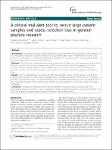A clinical trial alert tool to recruit large patient samples and assess selection bias in general practice research
Heinemann, Stephanie
Thüring, Sabine
Wedeken, Sven
Schäfer, Tobias
Scheidt-Nave, Christa
Ketterer, Mirko
Himmel, Wolfgang
Background: Many research projects in general practice face problems when recruiting patients, often resulting in low recruitment rates and an unknown selection bias, thus limiting their value for health services research. The objective of the study is to evaluate the recruitment performance of the practice staff in 25 participating general practices when using a clinical trial alert (CTA) tool. Methods: The CTA tool was developed for an osteoporosis survey of patients at risk for osteoporosis and fractures. The tool used data from electronic patient records (EPRs) to automatically identify the population at risk (net sample), to apply eligibility criteria, to contact eligible patients, to enrol and survey at least 200 patients per practice. The effects of the CTA intervention were evaluated on the basis of recruitment efficiency and selection bias. Results: The CTA tool identified a net sample of 16,067 patients (range 162 to 1,316 per practice), of which the practice staff reviewed 5,161 (32%) cases for eligibility. They excluded 3,248 patients and contacted 1,913 patients. Of these, 1,526 patients (range 4 to 202 per practice) were successfully enrolled and surveyed. This made up 9% of the net sample and 80% of the patients contacted. Men and older patients were underrepresented in the study population. Conclusion: Although the recruitment target was unreachable for most practices, the practice staff in the participating practices used the CTA tool successfully to identify, document and survey a large patient sample. The tool also helped the research team to precisely determine a slight selection bias.
Dateien zu dieser Publikation
Keine Lizenzangabe

